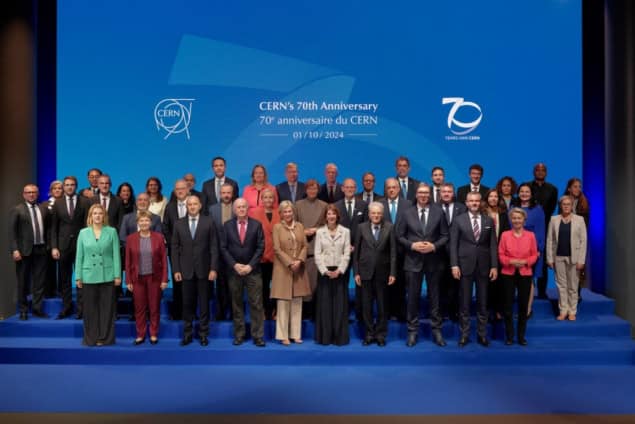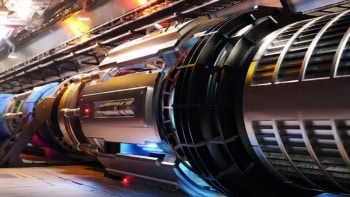
Officials gathered yesterday for an official ceremony to celebrate 70 years of the CERN particle-physics lab, which was founded in 1954 in Geneva less than a decade after the end of the Second World War.
The ceremony was attended by 38 national delegations including the heads of state and government from Bulgaria, Italy, Latvia, Serbia, Slovakia and Switzerland as well as Her Royal Highness Princess Astrid of Belgium and the president of the European Commission. It marked the culmination of a year of events that showcased the lab’s history and plans for the future as it looks beyond the Large Hadron Collider.
Created to foster peace between nations and bring scientists together, CERN’s origins can be traced back to 1949 when the French Nobel-prize-winning physicist Louis de Broglie first proposed the idea a European laboratory. A resolution to create the European Council for Nuclear Research (CERN) was adopted at a UNESO conference in Paris in 1951, with 11 countries signing an agreement to establish the CERN council the year after.
CERN Council met for the first time in May 1952 and in October of that year chose Geneva as the site for a 25–30 GeV proton synchrotron. The formal convention establishing CERN was signed at a meeting in Paris in 1953 by the lab’s 12 founding member states: Belgium, Denmark, France, West Germany, Greece, Italy, the Netherlands, Norway, Sweden, Switzerland, the UK and Yugoslavia.
On 29 September 1954 CERN was formed and the provisional CERN council was dissolved. That year also saw the start of construction of the lab in which the proton synchrotron, with a circumference of 628 m, accelerated protons for the first time on 24 November 1959 with an energy of 24 GeV, becoming the world’s highest-energy particle accelerator.
A proud moment
Today CERN has 23 member states with 10 associate member states. Some 17,000 people from 100 nationalities work at CERN, mostly on the LHC but the lab also does research into antimatter research and theory. CERN is now planning on building on that success through a Future Circular Collider, which if funded, would include a 91 km circumference collider to study the Higgs boson in unprecedented detail.
As part of the celebrations, this year has seen over 100 events organized in 63 cities in 28 countries. The first public event at CERN, held on 30 January, combined science, art and culture, and featured scientists discussing the evolution of particle physics and CERN’s significant contributions in advancing this field.

Angels & Demons, Tom Hanks and Peter Higgs: how CERN sold its story to the world
Other events over the past months have focused on open questions in physics and future directions; the link between fundamental science and technology; CERN’s role as a model for international collaboration; and training, education and accessibility.
The meeting yesterday, the culmination of this year-long celebration, was held in the auditorium of CERN’s Science Gateway, which was inaugurated in October 2023.
“CERN is a great success for Europe and its global partners, and our founders would be very proud to see what CERN has accomplished over the seven decades of its life,” noted CERN director general Fabiola Gianotti. “The aspirations and values that motivated those founders remain firmly anchored in our organization today: the pursuit of scientific knowledge and technological developments for the benefit of humanity; training and education; collaboration across borders, diversity and inclusion; knowledge, technology and education accessible to society at no cost; and a great dose of boldness and determination to pursue paths that border on the impossible.”
- You can watch a recording of the second instalment of Physics World Live, in which Tara Shears, Philip Burrows and Tulika Bose discuss what is in store for particle physics in the coming decades.



